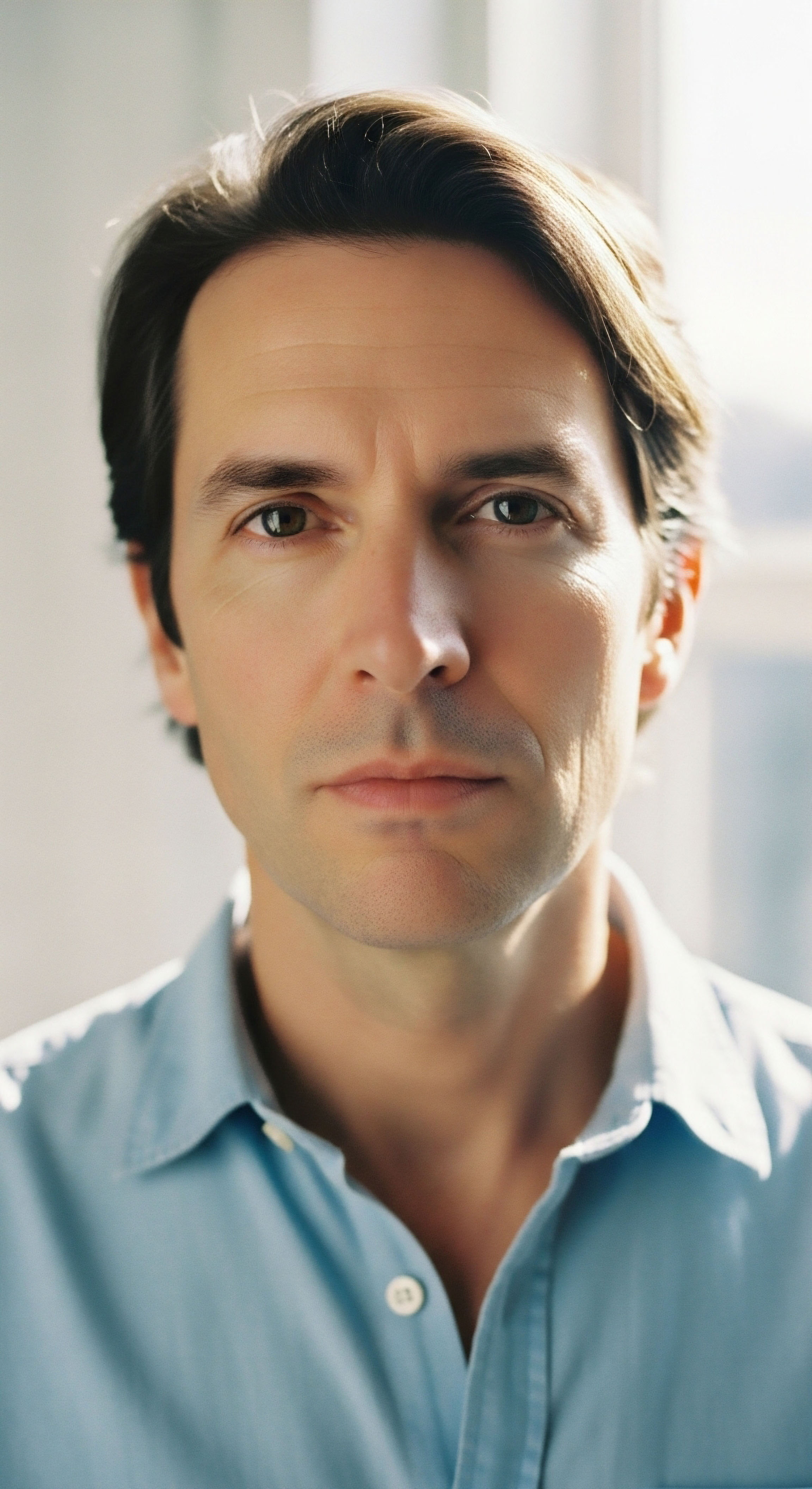

Fundamentals
You have started a journey toward reclaiming your vitality. The decision to begin a hormonal optimization protocol, such as Testosterone Replacement Therapy (TRT), often comes after a period of feeling that your body’s systems are no longer operating with their inherent strength.
You may have noticed a decline in energy, a fog clouding your thoughts, or a general sense of being out of sync with your own potential. The improvements you feel are real, tangible, and validating. They are a direct result of recalibrating a key biological system. It is from this new position of strength and clarity that you can now thoughtfully consider the full scope of your health, which naturally includes your reproductive wellness and future family-building goals.
Understanding the long-term outcomes of TRT on your reproductive health begins with understanding your body’s internal communication network. This network is governed by a precise and elegant feedback system known as the Hypothalamic-Pituitary-Gonadal (HPG) axis. Think of it as a highly sophisticated thermostat system designed to maintain hormonal balance.
Your hypothalamus, located in the brain, acts as the control center. It senses when testosterone levels are low and sends a signal ∞ Gonadotropin-Releasing Hormone (GnRH) ∞ to the pituitary gland. The pituitary, acting as the thermostat, responds by releasing two critical messenger hormones ∞ Luteinizing Hormone (LH) and Follicle-Stimulating Hormone (FSH).
These messengers travel through the bloodstream to the testes, which are the furnace. LH instructs the Leydig cells in the testes to produce testosterone. FSH, in parallel, signals the Sertoli cells to begin and maintain the production of sperm, a process called spermatogenesis.
Introducing external testosterone quiets the body’s natural command center for hormone production, leading to a significant reduction in sperm creation.
When you introduce testosterone from an external source through TRT, your hypothalamus senses that testosterone levels are adequate or high. In response, it stops sending the GnRH signal to the pituitary. The pituitary, receiving no signal, ceases its release of LH and FSH.
Without these stimulating hormones, the testes are no longer instructed to produce their own testosterone or to generate sperm. The “furnace” is effectively turned down because the control center believes the room is already warm enough. This shutdown of the HPG axis is the central mechanism by which TRT affects reproductive function.
The direct consequence is a dramatic decrease in sperm count, a condition known as oligospermia (low sperm count) or, in many cases, a complete absence of sperm in the ejaculate, known as azoospermia.

The Hormonal Signaling Cascade
The intricate dialogue between the brain and the testes is a foundational element of male physiology. The administration of exogenous testosterone interrupts this conversation, creating a new hormonal environment. While this new state can restore systemic functions related to muscle mass, mood, and libido, it places the reproductive machinery in a state of dormancy.
The testes, deprived of the pituitary’s stimulating signals, not only halt sperm production but may also decrease in size, a condition known as testicular atrophy. This physical change is a direct manifestation of the suppressed biological activity within the gonads. The process is a normal physiological response to the altered hormonal milieu. It is a predictable outcome based on the body’s own regulatory logic. Acknowledging this mechanism is the first step toward managing it effectively.

How Does TRT Alter the Body’s Natural Signals?
To visualize this change, consider the hormonal signals as a chain of command. In a natural state, the command flows from the top down. TRT provides the final product directly, which makes the higher levels of command redundant. This efficiency in delivering testosterone for systemic benefits comes at the cost of the secondary functions driven by that command chain, namely spermatogenesis. The table below illustrates this shift in signaling.
| Hormonal Signal | Natural State (Without TRT) | During TRT |
|---|---|---|
| Hypothalamus Signal (GnRH) | Pulsatile release to stimulate pituitary | Suppressed |
| Pituitary Signals (LH & FSH) | Released to stimulate testes | Suppressed or absent |
| Testicular Testosterone Production | Active | Suppressed or absent |
| Spermatogenesis (Sperm Production) | Active | Suppressed or absent |
This state of suppressed fertility is, in most individuals, a temporary and reversible condition. The potential for the HPG axis to “reawaken” after the cessation of TRT is high, especially when managed with clinical foresight. Research shows that sperm production typically recovers within a year after stopping therapy, although this timeline can vary based on individual factors like age and the duration of treatment.
For men who wish to preserve their fertility options while benefiting from hormonal optimization, specific clinical strategies exist to maintain testicular function even while on TRT. This allows for a proactive approach, ensuring that your long-term life goals are fully integrated into your immediate wellness plan.


Intermediate
Navigating the intersection of hormonal optimization and reproductive health requires a more granular understanding of the clinical tools available. Once you comprehend that TRT-induced infertility is a direct result of HPG axis suppression, the logical next step is to explore the strategies designed to counteract this effect.
These protocols are designed to either maintain testicular function during therapy or to efficiently restart it afterward. This moves the conversation from a passive acceptance of side effects to a proactive management of your body’s systems, ensuring your wellness protocol aligns with your life’s broader intentions, including the possibility of fatherhood.

Preserving Fertility during Hormonal Optimization Protocols
The primary strategy for maintaining fertility while on TRT involves providing a substitute signal for the one that has been suppressed. Since exogenous testosterone quiets the pituitary’s release of LH, the testes no longer receive the command to produce testosterone and support sperm maturation. The clinical solution is to introduce a compound that mimics the action of LH, thereby keeping the testes active. This is the role of Human Chorionic Gonadotropin (HCG).
HCG is a hormone that is structurally similar to LH. It binds to the same receptors on the Leydig cells in the testes. By administering HCG concurrently with TRT, you are essentially creating a bypass signal. While the brain and pituitary remain quiet, the HCG directly stimulates the testes, compelling them to continue producing intratesticular testosterone (ITT).
Maintaining high levels of ITT is absolutely essential for spermatogenesis. Systemic testosterone levels from TRT injections are insufficient to support this localized process within the testes. A typical protocol involves subcutaneous injections of HCG, often around 500 IU, two to three times per week. This approach has been shown to successfully maintain semen parameters in many men on TRT, preventing the onset of azoospermia.
Concurrent use of HCG with TRT acts as a direct stimulus to the testes, preserving the internal hormonal environment necessary for sperm production.
An additional consideration in this protocol is the management of estrogen. Both testosterone and HCG can lead to an increase in estrogen levels through the action of the aromatase enzyme. To manage potential side effects like gynecomastia or water retention, an aromatase inhibitor such as Anastrozole may be incorporated into the protocol. It works by blocking the conversion of testosterone to estrogen, helping to maintain a balanced hormonal profile.

Protocols for Restoring Fertility after TRT
For men who did not use HCG during their therapy or for those who have decided to cease TRT to pursue conception, the goal shifts to restarting the entire HPG axis. The body must be prompted to resume its own production of GnRH, LH, and FSH.
While spontaneous recovery occurs, it can be a slow process, sometimes taking a year or more. During this period, individuals may experience symptoms of hypogonadism as their bodies transition from an external supply of testosterone to endogenous production. To expedite this “reawakening” and mitigate symptoms, specific post-TRT protocols are used.
These protocols center on the use of medications known as Selective Estrogen Receptor Modulators (SERMs). The two most common SERMs used for this purpose are Clomiphene Citrate (Clomid) and Tamoxifen (Nolvadex). Enclomiphene, a more refined isomer of clomiphene, is also utilized.
- Clomiphene Citrate ∞ This compound works at the level of the hypothalamus and pituitary gland. It acts as an estrogen receptor antagonist in this region, essentially blocking the estrogen from signaling to the brain. The pituitary gland interprets this lack of estrogen signal as a sign that testosterone levels are low, prompting it to increase the production and release of both LH and FSH. This surge in gonadotropins provides the powerful stimulus needed to “wake up” the dormant testes, restarting both testosterone production and spermatogenesis.
- Tamoxifen ∞ Similar to clomiphene, tamoxifen also blocks estrogen receptors in the pituitary, stimulating the release of LH and FSH. It is another effective tool for restarting the HPG axis.
- HCG in Post-TRT Recovery ∞ Sometimes, HCG is used at the beginning of a post-TRT protocol, before or alongside SERMs. This provides an immediate jolt to the testes, kick-starting testosterone production to help alleviate hypogonadal symptoms while the rest of the axis slowly comes back online.

What Are the Differences in Fertility Restoration Agents?
Choosing the right agent or combination of agents depends on the individual’s specific situation, including the duration of their TRT cycle and their baseline hormone levels. The following table compares the primary agents used in fertility management related to TRT.
| Agent | Mechanism of Action | Primary Use Case | Key Considerations |
|---|---|---|---|
| Human Chorionic Gonadotropin (HCG) | Mimics LH, directly stimulating the testes. | Fertility preservation during TRT; initial kick-start after TRT. | Does not restart the HPG axis itself; can increase estrogen. |
| Clomiphene Citrate (Clomid) | Blocks estrogen receptors in the pituitary, increasing LH and FSH output. | Restarting the HPG axis after TRT; alternative to TRT for hypogonadism. | Can take several weeks to show effects; potential for visual side effects in some users. |
| Tamoxifen (Nolvadex) | Blocks estrogen receptors in the pituitary, increasing LH and FSH output. | Restarting the HPG axis after TRT, often used in combination protocols. | Effective at stimulating gonadotropins. |
| Anastrozole (Arimidex) | Aromatase inhibitor; blocks the conversion of testosterone to estrogen. | Managing estrogen levels during TRT or HCG therapy. | Requires careful dosing to avoid lowering estrogen too much, which has its own side effects. |
A comprehensive clinical approach involves a thoughtful conversation about your life goals before starting any hormonal protocol. If fertility is a future consideration, preserving it with HCG from the outset is often the most efficient path.
If you are already on TRT and wish to restore fertility, a structured post-cycle therapy involving SERMs and potentially HCG can effectively and efficiently bring your natural systems back online. This level of strategic management ensures that you can achieve the benefits of hormonal optimization without compromising your reproductive future.


Academic
A sophisticated analysis of the long-term sequelae of exogenous androgen administration on male reproductive health necessitates a deep examination of the molecular biology of the Hypothalamic-Pituitary-Gonadal (HPG) axis and the cellular dynamics within the testicular microenvironment. The clinical outcome of infertility is a predictable consequence of disrupting this axis’s negative feedback mechanisms.
The more complex and clinically significant question pertains to the stochasticity of recovery post-cessation and the efficacy of interventions designed to restore spermatogenic function. The durability of TRT-induced azoospermia is not uniform, and understanding the factors that dictate recovery timelines is paramount for clinical management and patient counseling.

The Molecular Basis of Gonadotropin Suppression and Testicular Quiescence
The administration of exogenous testosterone elevates serum androgen levels, which are detected by androgen receptors in the hypothalamus and pituitary gland. This triggers a potent negative feedback signal that drastically curtails the pulsatile secretion of Gonadotropin-Releasing Hormone (GnRH) from the hypothalamus. The subsequent reduction in GnRH stimulation of the anterior pituitary leads to a profound suppression of both Luteinizing Hormone (LH) and Follicle-Stimulating Hormone (FSH) synthesis and release. This is the central lesion induced by TRT.
The consequences within the testes are twofold and cell-specific:
- Leydig Cell Dysfunction ∞ The absence of LH stimulation causes Leydig cells to cease endogenous testosterone production. While systemic testosterone levels are maintained by TRT, the concentration of intratesticular testosterone (ITT) plummets. ITT levels are typically 50-100 times higher than serum levels, and this high local concentration is indispensable for the progression of spermatogenesis.
- Sertoli Cell and Germ Cell Disruption ∞ Sertoli cells, the “nurse” cells of spermatogenesis, are critically dependent on both FSH and high concentrations of ITT to support the development and maturation of germ cells. The withdrawal of FSH, combined with the collapse of ITT, leads to a halt in the spermatogenic process and can trigger apoptosis (programmed cell death) in developing germ cells, leading to the clinical states of severe oligospermia or azoospermia.

Predicting and Influencing the Reversibility of Azoospermia
The reversibility of this state is a critical area of clinical investigation. While most men do recover spermatogenesis, the timeline is highly variable. Several factors contribute to this heterogeneity:
- Duration and Dose of Androgen Exposure ∞ Longer periods of TRT and the use of higher, supraphysiologic doses (as seen with anabolic-androgenic steroid use) are correlated with a more profound and prolonged suppression of the HPG axis. This can lead to a longer recovery time.
- Age and Baseline Fertility ∞ Older men and individuals with pre-existing subfertility may experience a less robust or slower recovery of spermatogenesis compared to younger men with proven baseline fertility.
- Genetic Predisposition ∞ Underlying genetic factors may influence the resilience and recovery capacity of the HPG axis and testicular function, although this area requires more research.
The restoration of spermatogenesis post-TRT depends on a complex interplay of treatment duration, patient age, and the specific pharmacological agents used to reactivate the HPG axis.
A landmark study by the World Health Organization demonstrated that testosterone-induced azoospermia was reversible in healthy men, with a median time to recovery of sperm concentration to 20 million/mL being 3.7 months after cessation of weekly testosterone enanthate injections. However, clinical experience shows that this can extend to 12-24 months for some individuals, and a small percentage may not recover spontaneously at all.

How Can Advanced Protocols Accelerate HPG Axis Recovery?
Given the potential for prolonged recovery and associated hypogonadal symptoms, pharmacological intervention is often indicated. The use of HCG-based combination therapies represents a significant advancement in managing TRT-induced infertility. A retrospective study of 49 men with testosterone-related azoospermia or severe oligospermia demonstrated the efficacy of a protocol using high-dose HCG (3,000 IU every other day) supplemented with agents like clomiphene citrate, tamoxifen, or anastrozole.
This approach resulted in the return of spermatogenesis in 96% of participants within an average of 4.6 months. This is substantially faster than the timelines often observed with unaided withdrawal.
The rationale for this combination therapy is synergistic. HCG provides direct, potent stimulation to the testes, rapidly increasing ITT and providing symptomatic relief from hypogonadism. Simultaneously, SERMs like clomiphene citrate work upstream to restore the endogenous pulsatile release of LH and FSH, rebuilding the natural function of the entire axis. This dual approach addresses both the immediate testicular environment and the long-term restoration of the central signaling pathway.
Future directions may involve more nuanced protocols, potentially using recombinant FSH in select cases, or exploring the role of novel compounds like enclomiphene citrate, which may offer a more favorable side effect profile than clomiphene by being a pure estrogen receptor antagonist. The ultimate clinical objective is to provide personalized protocols that align with a patient’s reproductive goals, leveraging a deep understanding of endocrine physiology to both optimize wellness and preserve the potential for fertility.

References
- World Health Organization Task Force on Methods for the Regulation of Male Fertility. “Contraceptive efficacy of testosterone-induced azoospermia in normal men.” The Lancet, vol. 336, no. 8721, 1990, pp. 955-959.
- “Testosterone replacement therapy & male fertility ∞ A guide.” Give Legacy, 2023.
- “The Impact of Testosterone Use on Fertility.” Fertility Center of California, 2022.
- Wenker, E. P. et al. “The Use of HCG-Based Combination Therapy for Recovery of Spermatogenesis after Testosterone Use.” The Journal of Sexual Medicine, vol. 12, no. 6, 2015, pp. 1334-1340.
- Ramasamy, R. et al. “Recovery of spermatogenesis following testosterone replacement therapy or anabolic-androgenic steroid use.” Asian Journal of Andrology, vol. 18, no. 2, 2016, pp. 162-167.
- “TRT and Fertility ∞ how to get the best of both worlds ∞ Clomid and HCG ∞ part 2.” Ageless Forever, 2021.
- “Does TRT make you infertile? What you need to know.” IVI Fertility, 2025.
- Richlin, Spencer S. “Can Testosterone Replacement Therapy (TRT) Cause Infertility?” Illume Fertility, 2024.

Reflection

Charting Your Personal Health Timeline
The information you have engaged with is a map of a specific biological territory. It details the pathways, the junctions, and the clinical strategies available to navigate the relationship between hormonal vitality and reproductive health. This map provides you with the power of understanding. It transforms abstract concerns into concrete, manageable variables.
Your personal health journey, however, is your own unique territory. The decision to start a family, the timeline for that decision, and your individual physiological response are all unique to you.
Consider where you are on your timeline. Are your family-building years ahead of you, currently unfolding, or in the past? How does the knowledge of these hormonal systems and the tools to manage them influence your perspective on your long-term wellness plan?
The science provides the “what” and the “how,” but you define the “when” and the “why.” This understanding is the foundation for a more profound conversation with yourself, your partner, and your clinical guide. It is the starting point from which you can build a health strategy that honors every aspect of your life’s design.



